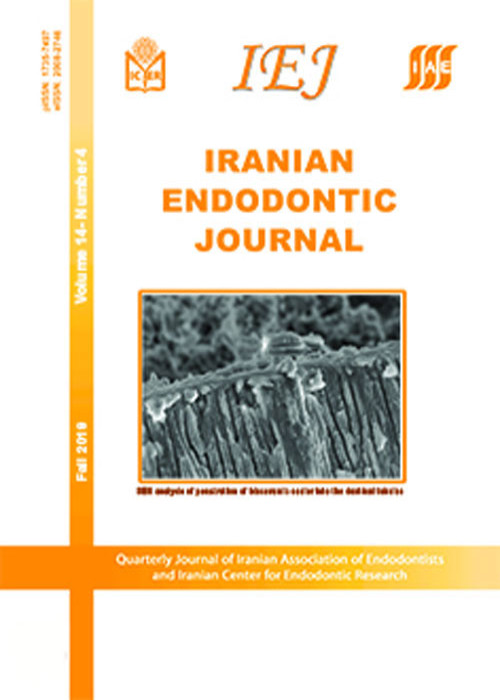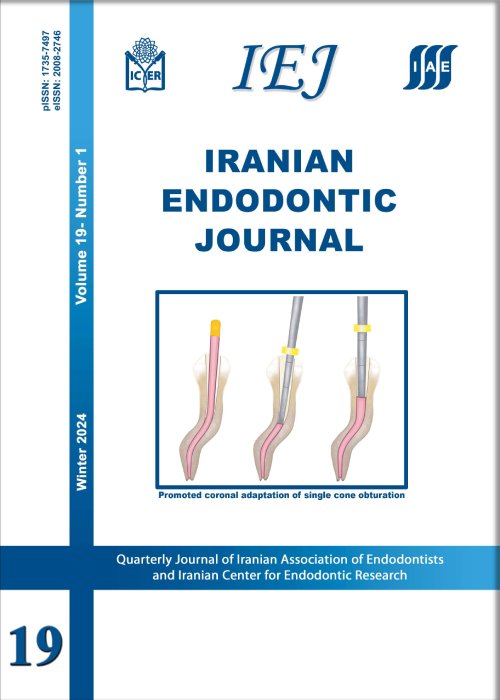فهرست مطالب

Iranian Endodontic Journal
Volume:18 Issue: 1, Winter 2023
- تاریخ انتشار: 1402/02/09
- تعداد عناوین: 8
-
-
Page 1
-
Pages 2-14Introduction
Crack formation has become an important issue for endodontists, as it can be decisive for the long-term prognosis of the endodontically treated tooth. Since the applicability of laser in endodontics has become frequent, this systematic review aimed to evaluate the association between laser therapy and the formation of cracks in the dentinal structure of the root canal.
Materials and MethodsA search was performed in PubMed, Scopus, Web of Science, and Virtual Health Library, as well as in the gray literature, on September 24, 2021. Studies that evaluated the formation of cracks in human root dentin due to different types of lasers were included. The risk of bias was assessed following the modified version of the Consolidated Standards of Reporting Trials (CONSORT) checklist tool. A meta-analysis was performed to evaluate (i) the total number of crack incidences; (ii) complete crack formation; (iii) incomplete crack formation; (iv) intra-dentinal crack formation between ultrasonic tips and laser use. The mean difference was calculated with a 95% confidence interval in a fixed-effect model, the heterogeneity was tested using the I2 index with level of significance of 5%.
ResultsOf the 22 studies included in this review, 15 have shown that lasers can form cracks in root dentin, including those that performed baseline assessment of samples. The meta-analysis confirmed no difference in crack formation between ultrasonic tips and laser devices.
ConclusionsLaser therapy has been gaining prominence in endodontics and that irradiation can form and propagate cracks in the dentinal structure of the root canal assessed by in vitro studies. This is a critical concern for endodontists as it affects the strength and longevity of the tooth. Future research is encouraged to seek the standardization of good methodological practices and achieve establishing parameters to minimize harmful effects of laser on dentin.
Keywords: Crack, Dentin, Lasers, Root Canal Therapy, Systematic Review -
Pages 15-40
Pulp treatment in primary dentition is generally divided into vital and non-vital pulp therapies and assists in the preservation of pulpally involved primary teeth in the dental arch until the affected tooth naturally exfoliates. The success of pulp therapies depends on several factors; e.g.proper case selection, accurate diagnosis and good coronal seal. To date, studies on the success and failure rates of pulp treatments are based on clinical signs and symptoms, radiographic findings and histological analysis. However, the clinical and radiographic evidence may not completely portray the true status of the dental pulp. Histological evidence remains the gold standard in the assessment of pulp condition, whether it is in a healthy or adverse state. The aims of the current research were to summarise the treatment outcomes of pulp therapy in primary dentition based on clinical, radiographic and histological criteria, and to support its relevance in the presence of limited histological evidence to measure authentic treatment success. An electronic database search of dental literature from 1990 to 2022 was carried out using the MEDLINE, i.e. PubMed,database. Current dental literature showed that the success rates of primary tooth pulp therapy are high. The obtained results were based largely on clinical and radiographic studies with narrow histological investigations to assess the treatment outcome(s) of pulp therapy in primary dentition. Despite the scarcity of histological evidence, pulp therapies in primary teeth are still practical due to their statistically empirical success compared to their failure. Consequently, pulp therapy of primary dentition is still relevant, and should continue to be indicated as an important treatment option.
Keywords: Histological Evidence, Primary Dentition, Pulp Therapy, Success Rate, Treatment Outcomee -
Pages 41-46Introduction
The present study aimed to compare the capability of two single-file shaping systems in disinfecting and cleaning long oval root canals.
Materials and MethodsFifty single-rooted teeth were prepared, contaminated with Enterococcus faecalis and divided into two groups. Two samplings were obtained; S1 before chemo-mechanical preparation and S2 after the preparation. Depending on the group, chemo-mechanical preparation was performed with XP-endo Shaper (XPS) and Wave One Gold (WOG). Five teeth from each group were observed under scanning electron microscopy (1000×) to evaluate the cleanliness of root canals at 3, 6 and 9 mm from the apex. All probability (P-values) were two-tailed, statistical significance was set at 0.05 and analyses were conducted using SPSS statistical software.
ResultsA significant reduction in the colony forming units was observed from S1 to S2 in both tested groups. In S2, XPS group obtained significantly lower colony forming units (P<0.001). In the cleanliness study, XPS group resulted in significantly cleaner canals compared to WOG.
ConclusionsBased on this in vitro study XPS system was more effective in disinfecting and cleaning long oval canals.
Keywords: Anatomical Instruments, Oval Canals, Reciprocating, Wave One Gold, XP-endo Shaper -
Pages 53-58
lntroduction:
Disinfection of the root canal system is crucial for a successful endodontic treatment. Several factors influence the performance of effective irrigation. Diverse irrigating substances have been used but none has proved to completely penetrate the root canal system. HybenX dries biofilmdue to its hygroscopic properties; therefore, it is effective in the treatment of biofilm-related diseases.This investigation aimed toestimate HybenX’s degree of penetration into the dentinal tubules of upper first premolars.
Materials and MethodsExperimental in vitrointervention where 30 extracted maxillary premolars were evaluated to determine HybenX’s degree of penetration and 5% sodium hypochlorite in the dentinal tubules using three different irrigation techniques (passive ultrasonic irrigation, dynamic manual irrigation and conventional single jet irrigation technique). After preparation, the root canals were irrigated with fluorescent rhodamine 6G; then 500-micrometer sections were made to be analyzed under a fluorescence microscope. Measurements were made in micrometer in ZEN software to determine the penetration degree of each substance in the different root thirds.
ResultsIn the apical third, significant differences between the 3 irrigation techniques were found (P<0.05), similarly, for the middle and cervical thirds. Significant statistical differences between the HybenX and sodium hypochlorite were found at the cervical and middle levels when using the conventional Monoject irrigation and passive ultrasonic irrigation techniques. As for the apical level, differences were found between the passive ultrasonic irrigation techniques and the dynamic manual irrigation technique.
ConclusionsBased on this in vitrostudy, HybenX proved to highly penetrate into the dentinal tubules, especially when using the passive ultrasonic irrigation technique. HybenX may be a useful option for root canal irrigation in endodontics.
Keywords: Biofilms, Hybenx, Root Canal Irrigants, Root Canal Preparation -
Pages 59-62
Endodontic therapy of dens invaginatus (DI) anomalies is challenging due to difficult access, inadequate cleaning and shaping, and incomplete disinfection of its complicated root canal system. The present case report describes the treatment of tooth #10 with tooth discomfort, intermittent pus discharge, and localized swelling. Sinus tract, mobility, and probing grade 1 were observed. The tooth was tender on palpation and percussion with negative responses to pulp sensibility tests. Radiographic assessments revealed an atypical structure of pulpal anatomy, probably dens invaginatus, associated with a large periapical lesion and severe root curvature. Cone-beam computed tomography confirmed the presence of DI type II. Finally, the diagnosis of pulp necrosis with chronic apical abscess of tooth #10 was made. Combining antimicrobial photodynamic therapy as an adjunctive treatment with different irrigation techniques were effective in nonsurgical endodontic management of the complicated DI type II in a maxillary lateral incisor with a large periradicular lesion and severe root curvature. Six-month and one-year recall radiographic images revealed asymptomatic tooth and progressive osseous healing.
Keywords: Cone-beam Computed Tomography, Dens Invaginatus, Disinfection, Endodontics, Photodynamic Therapy -
Pages 63-64
The current case study presents the surgical endodontic retreatment of a central incisor with a large periapical cyst that had extended to the adjacent lateral incisor. After anaesthesia, a full mucoperiosteal flap was carefully incised and completely reflected. Then, the cyst was cautiously excised without performing curettage of the apical region of the adjacent tooth. A 3-mm deep root-end cavity on tooth #21 was prepared, filled and sealed with calcium-enriched mixture cement. At 6-month and 4-year follow-ups, tooth #21 was fully functional and exhibited no clinical signs/symptoms, and complete periapical healing was evident. This report indicates the importance of proper diagnosis as well as a careful surgical approach in the successful management of comparable cases without the overtreatment of involved teeth.
Keywords: Calcium compounds, Calcium-enriched mixture, Endodontics, Retreatment, Tooth pulp, Tricalcium silicate -
Pages 65-70
Perforations are managed by surgical or nonsurgical approach depending on the relationship of the perforation site to the crestal bone level and attachment apparatus. Relocating the canal orifice or root canal close to the perforation site is quite challenging even with the aid of a dental operating microscope. In these two case reports, guided endodontics was applied in root canal localization and preparation in cases of furcation perforations. This is the report of two patients (42 and 15-year-old, respectively) who were referred for root canal treatment of the mandibular right first molar. The first case complained of pain on biting, foul odor, and bad taste. The referring dentist noted a furcation perforation and an inability to locate the mesial canals. Radiographic examination showed furcation radiolucency. Definitive diagnosis was symptomatic apical periodontitis. The second case complained of severe throbbing pain along with pain on biting. Mesial canals could not be detected due to a furcation perforation as noted by the referring dentist. Radiographic examination revealed a large furcation perforation and related bone resorption. Definitive diagnosis was acute apical abscess. In each case, a silicone impression of the mandibular arch was obtained and scanned along with cone-beam computed tomography scan to plan for localization and preparation of the mesiobuccal canals using implant planning software. Multiple guides were fabricated through rapid prototyping and allowed for the correct orientation and insertion of endodontic files through the canal. Canals were prepared and then obturated using warm vertical compaction technique and the perforation were repaired by mineral trioxide aggregate (MTA). Six-month and one-year follow-ups revealed no symptoms and evidence of radiographic healing. Thus, multiple endodontic three-dimensional guides can be successful in root canal localization and preparation in cases of furcation perforations.
Keywords: Case Report, Cone-beam Computed Tomography, Furcation Perforation, Guided Endodontics, Multiple Guides


